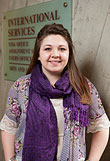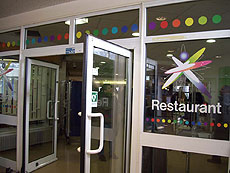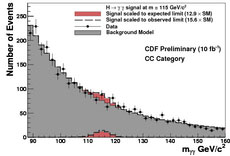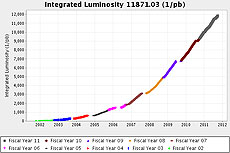|
Have a safe day!
Thursday, Feb. 2
2:30 p.m.
Theoretical Physics Seminar - Curia II
Speaker: Joachim Kopp, Fermilab
Title: Phenomenology with Sterile Neutrinos
3:30 p.m.
DIRECTOR'S COFFEE BREAK - 2nd Flr X-Over
THERE WILL BE NO ACCELERATOR PHYSICS AND TECHNOLOGY
SEMINAR TODAY
Friday, Feb. 3
3:30 p.m.
DIRECTOR'S COFFEE BREAK - 2nd Flr X-Over
4 p.m.
Joint Experimental-Theoretical Physics Seminar - One West
Speaker: Camillo Mariani, Columbia University
Title: Constraining Electron Neutrino Backgrounds for Low Energy
Neutrino Oscillation Experiments
Saturday, Feb. 4
8 p.m.
Fermilab Art Series - Ramsey Auditorium
Ladysmith Black Mambazo
Tickets: $30/$15
Click here for NALCAL,
a weekly calendar with links to additional information.
Upcoming conferences |
|
Thursday, Feb. 2
- Breakfast: Apple sticks
- Minnesota wild rice w/ chicken
- Tuna melt on nine grain
- Smart cuisine: Italian meatloaf
- Chicken casserole
- Buffalo crispy chicken wrap
- Assorted sliced pizza
- Chicken pecan salad
Wilson Hall Cafe Menu
|
|
Friday, Feb. 3
Dinner
Closed
Wednesday, Feb. 8
Lunch
- Cheese fondue
- Marinated vegetable salad
- Mixed berry pie
Chez Leon Menu
Call x3524 to make your reservation. |
|
International and need help? Call Samanatha Poeppelman.
 |
|
Samantha Poeppelman
|
Samantha Poeppelman was going to study biology in college, but that was before she fell in love with international relations. Now she is Fermilab's new International Services Administrator and will help foreign nationals at Fermilab navigate everything from temporary work contracts to basic life services.
Poeppelman, who is from a small town in Ohio, made the decision to study international relations during her freshman year at the University of Kentucky.
"I lived behind the international students' dorm. If I hadn't lived there and made so many friends who were international students, I would have become a doctor," Poeppelman said.
In addition to studying international relations, Poeppelman has traveled all over the world, including a four-month study abroad in Spain and Morocco, a summer education tour group in Italy and time in both Latin America and Turkey.
Before accepting this position at Fermilab, Poeppelman spent her summer completing a 10-week long internship with the National Council on U.S.-Arab Relations, where she attended multiple seminars with political figures and worked with AMIDEAST to facilitate study abroad programs between the U.S. and the Middle East.
Read more
—Sarah Charley
|
Introducing LHC Lunch
 |
|
The entrance to CERN's Restaurant 1. Photo: Amy Dusto
|
Editor's note: This article comes from US LHC intern Amy Dusto, who is currently working as a communicator at CERN. She is introducing LHC Lunch, a series of articles and videos she created while getting to know some of the members of experiments at the Large Hadron Collider from U.S. institutions.
The busy cafeteria known as Restaurant 1 is generally The Place to meet anyone at CERN. So, in order to gather stories from U.S.-based researchers working here, I met with eight of them over lunch.
The people I interviewed are experimentalists, students, professors and career changers. They represent each of the four main experiments: ALICE, ATLAS, CMS and LHCb. They followed different paths to CERN but share similar goals in science.
I've written a story for each of them, captured their voices on camera and – why not? – also documented what they ate. All this is set to appear on a new page of the US LHC website called LHC Lunch.
Read more
—Amy Dusto
|
Life after Tevatron: Fermilab still kicking even though it is no longer top gun
From Scientific American Observations Blog, Feb. 1. 2012
Fermilab is dead. Long live Fermilab!
The Tevatron at the Fermi National Accelerator Laboratory in Batavia, Ill., which had been the top U.S. particle collider—and for many years the most powerful such machine in the world—shut down last September. The collider's physics breakthroughs, including the 1995 discovery of the top quark, were so eminent that it was easy to think of the Tevatron and its host institution as one and the same.
But even though protons and antiprotons no longer course through the six-kilometer loop of the Tevatron, life at Fermilab goes on. Physics World editor Margaret Harris reports on a recent lab visit (registration required):
The end of the Tevatron does not, however, mean the end of Fermilab. "We have 10 accelerators here on site," says Fermilab physicist Steve Holmes, with the merest hint of irritation. "We turned one of them off, okay?" Like several scientists I spoke to, Holmes was keen to point out that colliding high-energy beams of particles is not the only way of discovering new physics with accelerators.
Read more
|
3Qs: Physicists push for underground testing facility
From the newsroom of Northeastern University, Jan. 31, 2012
Pran Nath, the Matthews Distinguished Professor of Physics at Northeastern University, is among a group of leading theoretical physicists who have asked the Department of Energy to develop a large underground neutrino facility to maintain U.S. leadership in the frontier of particle physics. We asked Nath to explain the facility and its value.
What is the Long Baseline Experiment (LBNE) and why is an underground facility essential to its success?
Neutrinos are mysterious objects that hold the key to understanding many natural phenomena, including why our universe is made up of matter instead of anti-matter. Neutrinos also play a key role in supernova explosions, which are responsible for the origin of heavy elements and, thus, life itself.
LBNE will seek to unravel the mysteries of the neutrino. It will produce neutrinos at Fermilab in Illinois and direct them to a multipurpose detector at Homestake gold mine, 1,200 kilometers away in Lead, South Dakota.
Read more
|
|
CDF's brightly lit offices
 |
|
CDF's full dataset consists of information from 10 inverse femtobarns.
|
In 2003, Higgs boson searches at the Tevatron were merely sparks in the eyes of physicists at CDF and DZero. After two years of slow running, the Tevatron had delivered a dataset only half as large as the previous Tevatron run in the 1990s. The earlier dataset yielded the discovery of the top quark.
While the data collected by 2003 produced one million W bosons, if the Higgs boson really exists as predicted, only about two Higgs bosons would have been produced by 2003 in each experiment. Even if these events passed selection criteria, they would be too hard to distinguish from other physics processes that mimic the Higgs signature. Much more data would be necessary to give the experiments a shot at discovering or excluding this amazing particle. Its existence would explain how the fundamental particles (for instance, electrons and quarks) of the universe acquire mass. For many, the outlook was bleak.
But a torch of hope was lit. Someday, the CDF and DZero collaborations would have 10 inverse femtobarns of data with which to find their Higgs boson. A femto is a small fraction, and a barn is a measure of area. An inverse femtobarn is the number of collisions happening in a very small area, in the center of the CDF and DZero detectors. With 10 inverse femtobarns, CDF and DZero would together have about one thousand
Higgs bosons for their most sensitive analyses - that is, if the Higgs boson really exists.
This torch, which appeared dim at first, began to glow brightly over the years. It kept many sleepless graduate students and post-doctoral researchers awake at night, preparing never before used analysis techniques to extract the Higgs boson signal from their data.
The Tevatron delivered. In a heroic effort of ingenuity, the men and women of the accelerator division delivered almost 12 inverse femtobarns to CDF and DZero. The CDF detector was fully functional and its data acquisition systems kept up with about 10.1 of the femtobarns. CDF collaborators have sorted through this data methodically. CDF reports its
first Higgs analysis of a full 10 inverse femtobarns of carefully selected data, in a search for the Higgs boson decay to two very energetic photons. In the coming months, the full dataset will be added to the dozen independent analyses that comprise CDF's search for the Higgs boson. Analysis efforts are as strong as ever, and the sensitivity for the Higgs boson is expected to improve as much from the new data as it will from better analysis technique. CDF students and post-doctoral researchers are fighting to get that last improvement in to their Higgs analysis, demanding that no Higgs event get left in the dark. Their feverish efforts are now brightly lit by the torch of 10 inverse femtobarns of luminosity.
—Edited by Ben Kilminster and
Andy Beretvas
 |
| We wish to thank the Accelerator Division for providing
10 inverse femtobarns of luminosity!
|
|
|